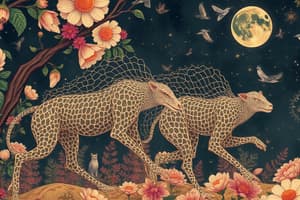Podcast
Questions and Answers
What is the principle mechanism that drives most evolution?
What is the principle mechanism that drives most evolution?
- Mutation
- Gene flow
- Natural selection (correct)
- Genetic drift
What is the main job of organisms?
What is the main job of organisms?
- To achieve immortality
- To survive and reproduce (correct)
- To adapt to the environment
- To create a diverse gene pool
Who put evidence for the idea of evolution all in one place?
Who put evidence for the idea of evolution all in one place?
- Charles Darwin (correct)
- Jean-Baptiste Lamarck
- Gregor Mendel
- Alfred Russel Wallace
What is biological/organic evolution?
What is biological/organic evolution?
What level does evolution go beyond?
What level does evolution go beyond?
What is the mechanism causing change in evolution?
What is the mechanism causing change in evolution?
What are the two concepts of evolution mentioned in the text?
What are the two concepts of evolution mentioned in the text?
What does natural selection act on?
What does natural selection act on?
What drives most evolution?
What drives most evolution?
What is the main goal of organisms according to the text?
What is the main goal of organisms according to the text?
What is the level at which natural selection acts?
What is the level at which natural selection acts?
What are the 4 points of biological or organic evolution mentioned in the text?
What are the 4 points of biological or organic evolution mentioned in the text?
What is the primary focus of natural selection?
What is the primary focus of natural selection?
How are advantageous phenotypes related to natural selection?
How are advantageous phenotypes related to natural selection?
What leads to the generation of new alleles in a population?
What leads to the generation of new alleles in a population?
What does the theory of evolution provide in relation to the creation of plants and animals by a god?
What does the theory of evolution provide in relation to the creation of plants and animals by a god?
Which of the following are key components of microevolutionary change?
Which of the following are key components of microevolutionary change?
What are the types of natural selection?
What are the types of natural selection?
What is the primary difference between macro-evolution and micro-evolution?
What is the primary difference between macro-evolution and micro-evolution?
What poses problems related to the species concept?
What poses problems related to the species concept?
What is the primary difference between sympatric and allopatric speciation?
What is the primary difference between sympatric and allopatric speciation?
When does convergent evolution occur?
When does convergent evolution occur?
What is co-evolution?
What is co-evolution?
What is gradualism in the context of evolutionary change?
What is gradualism in the context of evolutionary change?
Explain the concept of co-evolution and provide an example from the text.
Explain the concept of co-evolution and provide an example from the text.
Discuss the difference between sympatric and allopatric speciation as mentioned in the text.
Discuss the difference between sympatric and allopatric speciation as mentioned in the text.
Explain the concept of convergent evolution and provide an example from the text.
Explain the concept of convergent evolution and provide an example from the text.
Describe the differences between directional, disruptive, and stabilizing selection as types of natural selection as mentioned in the text.
Describe the differences between directional, disruptive, and stabilizing selection as types of natural selection as mentioned in the text.
Discuss the concept of macro-evolution as mentioned in the text and explain its relationship with micro-evolution.
Discuss the concept of macro-evolution as mentioned in the text and explain its relationship with micro-evolution.
Flashcards are hidden until you start studying
Study Notes
Understanding Evolutionary Biology
- Natural selection affects individuals, not populations, and leads to change over time in populations and species.
- Natural selection is like gravity, existing without a purpose, and advantageous phenotypes increase an organism's likelihood of survival and reproduction.
- Advantages genotypes and phenotypes change when the environment changes, and new alleles are generated from mutations or gene duplications.
- The theory of evolution does not disprove the creation of plants and animals by a god but provides a plausible alternative.
- Genetic drift, sexual selection, and the movement of genes into or out of a population are key components of microevolutionary change.
- Directional, disruptive, and stabilizing selection are the types of natural selection, each leading to different outcomes in allele frequencies.
- Macro-evolution concerns the evolution of new species and occurs over larger periods of time, with the mechanisms being the same as micro-evolution.
- A species is a population capable of interbreeding, but the species concept poses problems related to reproductive capability, asexual organisms, fossil organisms, geographic locations, and clines.
- Sympatric speciation and allopatric speciation are two forms of species evolution, with the former affecting reproduction by isolating a subset of a population.
- Convergent evolution occurs when two species independently evolve similar adaptations to the same environment, leading to analogous characteristics.
- Co-evolution is where the evolution of one species is strongly influenced by evolutionary changes in another species, such as in predator-prey interactions.
- Gradualism is the idea that evolutionary change happens over long periods of time, while punctuated equilibrium suggests that evolution occurs in rapid bursts separated by long periods of little change.
Understanding Evolutionary Biology
- Natural selection affects individuals, not populations, and leads to change over time in populations and species.
- Natural selection is like gravity, existing without a purpose, and advantageous phenotypes increase an organism's likelihood of survival and reproduction.
- Advantages genotypes and phenotypes change when the environment changes, and new alleles are generated from mutations or gene duplications.
- The theory of evolution does not disprove the creation of plants and animals by a god but provides a plausible alternative.
- Genetic drift, sexual selection, and the movement of genes into or out of a population are key components of microevolutionary change.
- Directional, disruptive, and stabilizing selection are the types of natural selection, each leading to different outcomes in allele frequencies.
- Macro-evolution concerns the evolution of new species and occurs over larger periods of time, with the mechanisms being the same as micro-evolution.
- A species is a population capable of interbreeding, but the species concept poses problems related to reproductive capability, asexual organisms, fossil organisms, geographic locations, and clines.
- Sympatric speciation and allopatric speciation are two forms of species evolution, with the former affecting reproduction by isolating a subset of a population.
- Convergent evolution occurs when two species independently evolve similar adaptations to the same environment, leading to analogous characteristics.
- Co-evolution is where the evolution of one species is strongly influenced by evolutionary changes in another species, such as in predator-prey interactions.
- Gradualism is the idea that evolutionary change happens over long periods of time, while punctuated equilibrium suggests that evolution occurs in rapid bursts separated by long periods of little change.
Studying That Suits You
Use AI to generate personalized quizzes and flashcards to suit your learning preferences.




